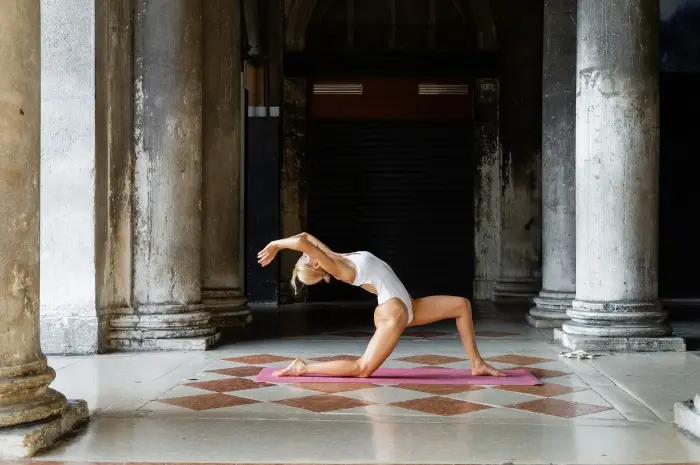Ashtanga Yoga, renowned as the eight-limbed yoga system, encompasses a profound and dynamic style of practice deeply rooted in ancient traditions. Its origins can be traced back to the esteemed sage Patanjali, who authored the Yoga Sutras.
In the 20th century, Sri K. Pattabhi Jois and his disciples played a pivotal role in popularizing Ashtanga Yoga.
This particular approach revolves around synchronizing breath with a progressive sequence of postures, generating internal warmth that purifies the body through detoxifying sweat, benefiting both muscles and organs.
The essence of Ashtanga Yoga lies in its postures, known as asanas, which are strategically sequenced. There are six sequences, or series, in Ashtanga Yoga: the Primary Series, Intermediate Series, and four Advanced Series.
Each series comprises a set of postures designed to align, strengthen, and purify the body. Let’s explore the significance of these postures, their execution, and the benefits they bring.
Similar Post: Inspiration for the Elegant New Kutu Kebaya Model
Primary Series: Yoga Chikitsa (Yoga Therapy)
The Primary Series, known as Yoga Chikitsa, aims to realign the body and detoxify the system. While suitable for beginners, it also poses challenges for advanced practitioners. It encompasses a sequence of standing poses, seated poses, twists, backbends, and inversions.
In the standing sequence, postures like Padangusthasana (Big Toe Pose) and Trikonasana (Triangle Pose) enhance flexibility, strengthen the legs, and stimulate abdominal organs.
Seated poses such as Paschimottanasana (Seated Forward Bend) and Baddha Konasana (Bound Angle Pose) promote hip flexibility and tranquility of mind.
The closing sequence, incorporating backbends like Urdhva Dhanurasana (Upward Bow Pose), invigorates and strengthens the spine.
Intermediate Series: Nadi Shodhana (Nerve Purification)
Nadi Shodhana, or the Intermediate Series, focuses on purifying the nervous system. It introduces a fresh array of postures and combinations, incorporating demanding arm balances and inversions.
Prior mastery of the Primary Series is essential before progressing to this level.
Postures like Pashasana (Noose Pose) and Krounchasana (Heron Pose) elongate the side body, improve digestion, while arm balances like Pincha Mayurasana (Feathered Peacock Pose) and inversions like Sirsasana (Headstand) strengthen the shoulders, arms, and enhance balance.
Advanced Series: Sthira Bhaga (Divine Stability)
Sthira Bhaga, commonly referred to as the Advanced Series, encompasses four distinct series (A, B, C, D), designed for highly proficient practitioners.
This advanced level of practice includes challenging arm balances, profound backbends, and intricate inversions.
Advanced postures like Eka Pada Sirsasana (Leg Behind Head Pose) and Yoganidrasana (Yoga Sleep Pose) enhance flexibility in the hips and spine, while strengthening poses like Vrischikasana (Scorpion Pose) develop upper body strength and balance.
The Importance of Vinyasa
Each Ashtanga sequence is punctuated by vinyasas, which are specific movements that link the postures and generate internal heat within the body.
This element plays a vital role in Ashtanga Yoga, increasing the cardiovascular aspect of the practice.
The vinyasas also act as resets between postures, allowing practitioners to return to a neutral state before transitioning to the next asana.
The Benefits of Ashtanga Yoga Postures
The postures in Ashtanga Yoga offer physical, mental, and emotional benefits. Physically, they improve strength, flexibility, balance, and coordination.
The sequences are designed to gradually open the body and build strength over time. They also stimulate various body systems, enhancing digestion, circulation, respiration, and the immune system.
Mentally, Ashtanga Yoga postures aid in developing concentration and awareness. The synchronization of breath and movement fosters a meditative state, calming the mind.
Emotionally, the practice of these postures can increase self-confidence and reduce anxiety levels. The discipline and concentration required in performing the postures can provide an emotional release, leading to improved mental well-being.
Highlight: Inspiration for a typical Betawi Encim Kebaya Model That Looks Elegant
In Conclusion
Ashtanga Yoga is a transformative journey of self-discovery and personal growth, offering practitioners an opportunity to test and transcend their physical and mental boundaries.
The series of postures in Ashtanga are not merely physical exercises; they are a spiritual practice aimed at purifying and aligning the body, breath, and mind.
Regular practice of Ashtanga Yoga can lead to a stronger, more flexible body, a calm and focused mind, and a heightened sense of awareness and connection to the world around us.
